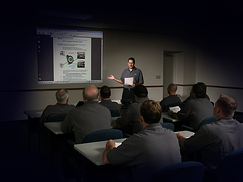Taking the Pain Out of Employee Training
 How do you go about training new workers on shop procedures, or introducing new procedures to existing employees? If you’re like many shops, you rely on more experienced employees to train others. Although this may be effective in some cases, it usually ties up valuable people and takes far longer than it should. A more cost-effective method is to document procedures on paper or electronically so they can be easily passed along multiple times, thus reducing the manpower involved.
How do you go about training new workers on shop procedures, or introducing new procedures to existing employees? If you’re like many shops, you rely on more experienced employees to train others. Although this may be effective in some cases, it usually ties up valuable people and takes far longer than it should. A more cost-effective method is to document procedures on paper or electronically so they can be easily passed along multiple times, thus reducing the manpower involved.
For this method to work effectively, however, the documentation must be thorough and easily understood. While this means an investment of time up front, the savings can be enormous as the material is used multiple times. Here are a few guidelines for developing effective documentation:
- Determine the appropriate medium.
- In many cases the best documentation is step-by-step written instructions with appropriate illustrations and/or photos to clarify procedures. For example, instructions on creating a new part program would include the steps to follow with screen shots of what the programmer will see on the control screen, plus photos of manual operations and machine movements.
- If the process is a complicated one, video may be an appropriate alternative to written instruction. A well-produced video provides a real-world look at how the steps are applied and what happens along the way. Although it’s tempting to simply set up a smart phone or digital camera and let it roll, studies show that video with good production values enhances learning.
- Combining written and video is a more powerful approach than either by itself. Just as some of us are right or left handed, we each have our own ways of processing new information. About one-third of us learn best by hearing, another one-third by seeing, and the remainder by touching. We use all three, of course, but each of us has a dominant way of learning. Therefore, combining written, verbal, visual and hands-on instruction is the most effective way to teach.
- Computers enable us to develop multi-media documentation that combines written, verbal and visual. Plus, with tablets such as the iPad, employees can train right on the shop floor where they can experience the procedures hands-on.
- Establish standards for all documentation. Regardless of the instructional media you choose, it’s best to establish a consistent format for documenting procedures. Otherwise each document will have variations that may inhibit learning. The best approaches are either to create a template into which text and images can be loaded, or to lay out strict guidelines. For example, you could decide to use a basic presentation format (Introduction, Body, Conclusion) with specific instructions for each part of the presentation. In the latter case, it’s best to work from an outline that keeps you focused. For example:
General Purpose:
Specific Purpose:
Central Idea:
Introduction
I
II
(Transition)
Body
I
A
B
C
(Transition)
II
A
B
C
(Transition)
III
A
B
C
(Transition)
IV
A
B
C
(Transition)
Conclusion
I
II - Use consistent wording. People can become confused if the terms used in one training document are different than those used in another. So use the most commonly accepted names for equipment, actions and processes every time. Additionally, be sure to provide specific information such as the precise type of material used to demonstrate a cutting technique, cutting tools used, etc.
- Don’t make training periods too long. As a society our attention span continue to become smaller and smaller. For this reason it makes sense to break down complex training topics into bite-sized pieces. Think in terms of taking the learner to a logical stopping point in a process and recapping what’s been covered so far. You might even insert a brief quiz that the learners can use to assess their own progress. If they answer the questions correctly, they can proceed to the next step. If not, they should go back and revisit the training to that point.
Educating employees is an on-going task, of course. And not every procedure lends itself to documentation. However creating effective training tools like these can save your company considerable time and expense, as well as insure that every employee is on the same page.